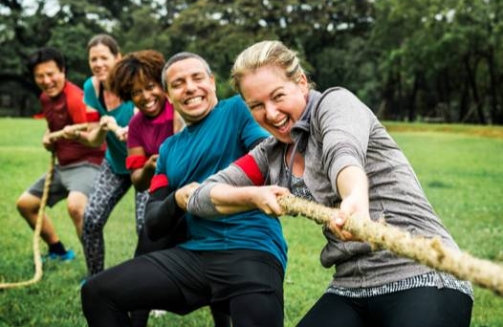We hope you find what you are looking for, if you need any further details please do contact our friendly team!
Team cohesion is a common team-building theory that occurs when a team is firing on all cylinders, and working together in a positive way to achieve a common goal. In many cases, a team that has achieved team cohesion is more focused on the team’s overall performance rather than individual performance. However, they will also appreciate their contributions and the contributions of others.
In essence, team cohesion is the team-building theory that people are more likely to support one another if they have a common goal or objective and they will remain more united in the face of adversity.
Gaining team cohesion or working towards it matters as it will make your team stronger and will encourage them to communicate with each other more often and more effectively. Overall, having a shared goal allows them to know that everyone plays an equally important role in achieving that goal and therefore is important to the process taken to achieve it. You will find that teams who have reached team cohesion are much more productive than other teams due to their improved communication efforts.
When it comes to forming and developing team cohesion, there are certain stages the team must progress through before they reach a stage of full team cohesion. These stages are described by psychologist Bruce Tuckman as forming, storming, norming and performing and they form a key part of this team-building theory.
Essentially, when a group reaches the performing stage, they have achieved full team cohesion. This means that the team is working productively together. They are focused on fulfilling the expectations of the team, and each individual understands how their place within the team and their contributions feed into that success.
As we all know, reaching team cohesion isn’t always a straight path. In some cases, it takes hard work, strong leadership and more than a few setbacks to achieve. That being said, there are certain ways and means of forging ahead with the goal of reaching team cohesion.
Alongside strong leadership, clearly defined goals, boundaries and open communication, team building is vital for team cohesion. Specifically, team building activities that offer the opportunity for groups of people to come together and get to know each other and understand how to work together.
Team building in ‘forming’ stages
During the storming stages of team cohesion development, conflict is to be expected. This arises as individuals test boundaries and acclimatise to the task at hand. In some cases, there may be a struggle for power or status, as bigger characters seek to establish themselves within the group.
Although conflict may seem like a bad thing at first glance, if managed correctly it can be channelled productively. Team building activities at this stage will allow the group to get into the groove of working together in a neutral environment. Team building in this stage can work to improve communication skills and get a better understanding of how fellow teammates work.
What is also key in the storming stage of team cohesion is developing a sense of trust and a bond between team members. Team building is an effective way to do this as it gives people the opportunity to motivate each other, build confidence and improve problem-solving skills, which will be key to moving through the storming stage.
Team building in ‘storming’ stages
During the storming stages of team cohesion development, conflict is to be expected. This arises as individuals test boundaries and acclimatise to the task at hand. In some cases, there may be a struggle for power or status, as bigger characters seek to establish themselves within the group.
Although conflict may seem like a bad thing at first glance, if managed correctly it can be channelled productively. Team building activities at this stage will allow the group to get into the groove of working together in a neutral environment. Team building in this stage can work to improve communication skills and get a better understanding of how fellow teammates work.
What is also key in the storming stage of team cohesion is developing a sense of trust and a bond between team members. Team building is an effective way to do this as it gives people the opportunity to motivate each other, build confidence and improve problem-solving skills, which will be key to moving through the storming stage.
Team building in ‘norming’ stages
Norming is typically a period of calm after storming. In this stage of team cohesion development, everyone is clear on their roles and responsibilities and is settling into them. When a team reaches the norming stage, it may be tempting to feel complacent, but there is still work to be done to maintain this new norm.
Team building can work to great effect to re-energise a team, create a competitive spirit and motivate everyone involved. Further to this, team building always presents an opportunity for growth and skills development, which will push the team forward to perform.
Team building in ‘performing’ stages
In the performing stage of team cohesion development, the team has reached their peak performance. They are working together well, reaching goals to deadlines and exceeding expectations. At this point, individual ego is no longer a priority. Instead, all members are focused on contributing to the success of the team. This is team cohesion!
There are plenty of signs of strong team cohesion that can be shown during the team development stage that proves team cohesion is working as desired. For example; if the team begins to see themselves as a complete unit rather than separate entities this is a sign of good team cohesion and this can happen quite early on in the team development process.
If the team can overcome conflict quickly and use their energy positively to grow their trust in one another this is another sign that team cohesion is working the way it is expected to.
There are many ways in which to improve team cohesion and to help your team develop together. It is very important to establish shared goals and values within the team very early on in the development process to ensure that the common ground between team members is set, then it is important to offer training and development opportunities to help the team members to share their knowledge and gain access to the knowledge they may not have yet. This will help the team to fill in their knowledge gap to reach a higher level of productivity.
Regular team-building can be used to help the team improve their communication skills and bond together to allow them to see the full potential of working together and demonstrate their efficiency as a team to each other.
At KDM Events, we develop team-building activities focused on developing key skills that build successful team cohesion. If you would like some help in supporting your team to reach team cohesion, contact us today. Our friendly team will be more than happy to help you formulate an away day or activity that is perfectly suited to capitalising on the strengths and supporting the growth of your workforce.
Many factors affect team cohesion, firstly, the team must be of a good size as it will prove difficult to have everyone within a large team communicating effectively when compared to a smaller team of individuals.
Another factor that affects team cohesion is the similarities between group members and their shared interests or shared successes as the more they have in common the more likely they are to see themselves as individuals in the other group members.
Having an external competitor or threat to overcome may also affect team cohesion as when working under pressure a team can act much differently.
Team cohesion usually develops as the group starts to share a common goal or shared sense of purpose but overall they begin to achieve success that they share together. Team cohesion also comes through the team’s shared working norms or agreed ways of working together.
A sports team is a great example of team cohesion in action as each team member has a shared goal and all work together to achieve it despite their differences as individuals.
Team cohesion is not directly measurable, however, there are various methods you can use to gain a good sense of how your team views themselves and how happy they are with the team’s work and overall success, this can be achieved via an employment satisfaction survey or a survey taken after a team-building activity.
Team-building activities help to keep your teams connected and bonded with one another and allow them to contribute towards a positive employee experience. They also help to inspire your team members and give them a reason to work as a harmonious unit not just as separate individuals.

